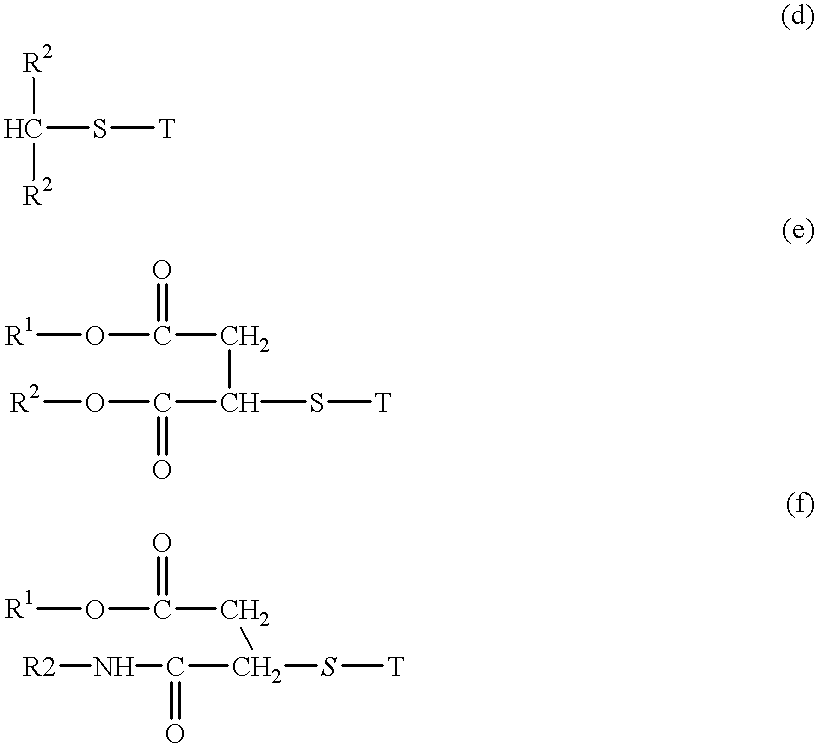Polyacrylamide surface modifiers for silver carboxylate nanoparticles
a technology of silver carboxylate nanoparticles and polyacrylamide, which is applied in the field of photothermographic materials, can solve the problems of large crystals, inability to provide the desired improved properties, and difficulty in preparing these photothermographic silver halide materials
- Summary
- Abstract
- Description
- Claims
- Application Information
AI Technical Summary
Problems solved by technology
Method used
Image
Examples
example 2
[0115] This is a comparative example.
[0116] Preparation of an Aqueous Microparticulate Silver Behenate (AgBeh) Colloidal Dispersion
[0117] An aqueous AgBeh microparticulate dispersion was prepared AgBeh dispersion as follows.
[0118] The following ingredients were blended in a 5 liter container:
[0119] 1) 600 grams of, 35% solids, aqueous silver behenate (AgBeh) "wet cake";
[0120] 2) 676.1 grams of 6.2% aqueous solution of polyvinyl alcohol (PVA, Elvanol.TM. 52-22 86-89% hydrolyzed (Dupont))
[0121] The resulting mixture was mixed for 2 hours at high-speed (4200 rpm) using a Cowles-type saw tooth impeller (40 mm diameter) at the temperature of 21.degree. C.
[0122] The particle morphology was characterized using scanning electron microscopy and particle size distribution of the resulting nanoparticulate dispersion was determined using a Horiba LA-920 Ultra Fine Particle Analyzer (Horiba Instruments Inc).
[0123] The particle size distribution curves (FIG. 1) indicate that the micromilling proc...
example 4
[0130] This is a Comparative Example
[0131] Aqueous Photothermographic Imaging Element Formulated Using Microparticulate AgBeh Dispersion.
[0132] A photothermographic element was formulated, coated, exposed and heat processed as described in Example 3 except that the nanoparticulate dispersion of Example 3 was replaced with the microparticulate dispersion of Example 2. The resulting sensitometric curves show that the element of the invention is about 0.2 Log E faster than the microparticulate dispersion.
example 5
[0133] Preparation of an Aqueous Nanoparticulate Silver Behenate (AgBeh) Colloidal Dispersion Using Controlled Precipitation
Procedure for Precipitation of Nanoparticulate Silver Behenate
[0134] A 18 liter reactor was charged with 9.97 kg of water, 363 g of 18.16% aqueous solution of ML-41 surfactant, and 279.6 g of behenic acid. The contents were stirred at 150 RPM with an anchor stirrer and heated to 70.degree. C. Once the mixture reached 70.degree. C., 390.7 g of 10.85% aqueous potassium hydroxide were added to the reactor. The mixture was heated to 80.degree. C. and held there for 30 minutes. The mixture was then cooled to 70.degree. C. When the reactor reached 70.degree. C., 1000 g of 12.77% aqueous silver nitrate were fed to the reactor in 5 minutes. After the addition, the nanoparticulate silver behenate was held at the reaction temperature for 30 minutes. It was then cooled to room temperature and decanted. A silver behenate dispersion with a median particle size of 160 nm was...
PUM
| Property | Measurement | Unit |
|---|---|---|
| particle size | aaaaa | aaaaa |
| size | aaaaa | aaaaa |
| particle size | aaaaa | aaaaa |
Abstract
Description
Claims
Application Information
 Login to View More
Login to View More - R&D
- Intellectual Property
- Life Sciences
- Materials
- Tech Scout
- Unparalleled Data Quality
- Higher Quality Content
- 60% Fewer Hallucinations
Browse by: Latest US Patents, China's latest patents, Technical Efficacy Thesaurus, Application Domain, Technology Topic, Popular Technical Reports.
© 2025 PatSnap. All rights reserved.Legal|Privacy policy|Modern Slavery Act Transparency Statement|Sitemap|About US| Contact US: help@patsnap.com



